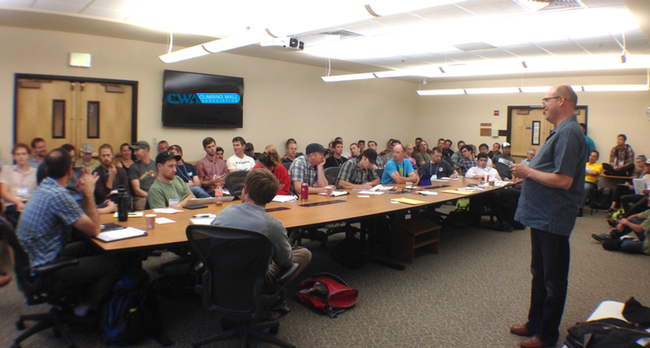
This past Saturday marked the conclusion of the 9th annual Climbing Wall Summit, organized by the Climbing Wall Association. The annual conference of the indoor climbing industry brought close to 500 current and aspiring gym owners from across the USA and beyond to Boulder, CO for two days of conference sessions and several additional days of pre-conference workshops.
According to numerous participants CBJ talked to at the event, the Summit continues to offer valuable information, but for different reasons for different attendees. For the aspiring gym owner, the sessions provided an overload of practical advice on everything from site selection to financing, operations, risk management, marketing and routesetting. These eager entrepreneurs were also able to mingle and get advice from experienced operators.
For the veteran gym owner, the conference offered an opportunity to hear how other gym owners and managers have solved problems they are facing. Some of this information sharing took place in workshops such as the very popular Owner’s Roundtable and Manager Roundtable, and a lot of advice was shared in restaurants and bars around town; the event is the one time during the year when all these professionals are in the same part of the country and attendees make the most of this networking opportunity.
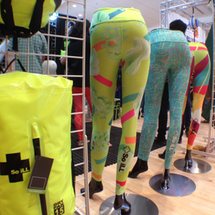 |
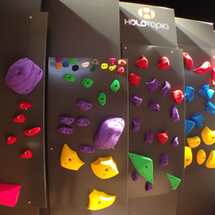 |
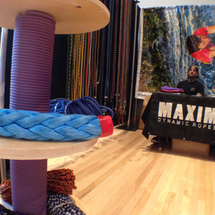 |
Hot Topics
It’s impossible to do justice to the many topics theat were covered in the Summit’s pre-conference workshops and sessions, but here is a sampling of interesting risk management topics we heard at the event.
OSHA
The Operational Safety and Health Administration has federal regulations governing the safety of people at work. According to Bill Zimmerman, CEO of the CWA, in the past year there has been a number of unannounced visits by OSHA inspectors at U.S. climbing gyms. These visits can result in fines if all OSHA regulations are not being followed, particularly those rules applicable to routesetters, such as Portable Ladders (1910.26), Manlifts (1910.68) and Personal Protective Equipment (1910.132).
One gym owner that recently had an OSHA audit (one that was triggered by an after-hours injury of an employee) claimed that having their staff certified under the Climbing Wall Instructor program offered by the CWA was immensely helpful during the inspection. They were able to show that the staff had been trained under a nationally recognized program, and they had ample documentation to go along with it.
Another owner suggested proactively reaching out to OSHA and requesting a friendly visit. In this situation the inspectors won’t be looking to write fines, but will provide recommendations on how you can operate safely and in compliance with the regulations.
Rick Vance, Petzl America’s Technical Director and a CWA Board Member, stressed during the Policy Plenary that if the climbing gym industry does not proactively create its own workplace safety guidelines, the industry is likely to see additional regulations imposed by OSHA. Luckily, the CWA is already working with Vance to develop employee safety guidelines. The CWA is also planning to host, in partnership with the Petzl Technical Institute, another Work at Height training this fall.
Drug Use
With three states now allowing recreational marijuana use, and another 20 allowing medical use, the issue of marijuana and climbing was a concern for many attendees. However it’s important that gyms have a policy around impairment, from any substance, and train their staff on how to deal with this issue. To help them properly identify a customer under the influence of drugs or alcohol, one participant suggested that gyms could send staff to alcohol sales training, through your state alcohol board or private companies like TIPs, which provide instruction on how to recognize the signs of intoxication (This training also comes in handy if you ever serve alcohol at events in your gym).
 |
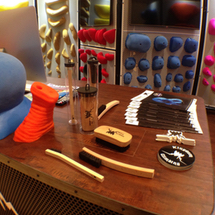 |
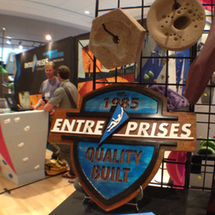 |
Bouldering Injuries
According to Mark Grossman, President of Monument Sports Group, the official insurance partner of the CWA, bouldering-related injuries are the number one cause of insurance claims. A number of ideas were discussed on how to reduce the incidence of bouldering injuries. The most important thing a gym owner can do is ensure their facility has a uniform landing surface in the bouldering area; the era of the drag mat is over. An informal poll of participants in one session found that every gym that transitioned from drag mats to seamless padding systems saw a significant reduction in injuries.
One gym owner shared that after tracking the location of accidents in the bouldering area they found that one section of the wall was responsible for the majority of incidents. They added a set of large downclimb holds to that section, and as a result of this simple measure they reduced their injury rate dramatically. A different gym owner revealed that after opening their bouldering facility they had a large number of injuries with new climbers. In response they changed their routesetting procedures to ensure that all V0-V2 climbs did not go higher than 11 feet; after this change they found that the majority of their injuries went away.
The Bouldering Orientation, and in particular fall training was a challenging topic. The possibility of having an employee or a customer injure themselves during a fall training, with the potential for a lawsuit or workers comp claim, keeps many gyms from implementing this at their facilities.The upside, however, of ensuring that everyone that climbs at the gym knows the basics of proper falling and landing technique means that many gyms are looking for ways to provide training with a minimal amount of risk.
Autobelay Accidents
Autobelays have become commonplace at rope gyms around the country, and unfortunately so has the incidence of accidents resulting from users, most often experienced climbers, forgetting to clip into the device and not have a belay partner to catch the error. As a result gyms have started using belay barriers, alarms, special hold colors and copious amounts of signage to prevent this “unintentional soloing”. Nonetheless, accidents remain all too common, and according to Grossman at Monument Sports Group, they are the second most common cause of insurance claims in the indoor climbing industry.
To reverse this trend gyms should ensure that they are providing a robust autobelay orientation. The autobelay must be treated just like any other piece of climbing equipment; just showing users how to unscrew the carabiner and clip their harness is not sufficient. Training should include how the device works, how to properly use it, and what to do if there is an equipment failure. Some gyms even teach people what to do if they do find themselves unclipped on the wall, and of course, staff should be trained on and should practice how to rescue a climber in this situation.
A more effective, but tougher solution to implement, is to bring back the buddy system. This would require autobelay users to have a climbing partner that checks their belay before leaving the ground. Alternatively gyms could put all autobelays in one area of the gym and only allow climbers to use them when there is staff supervision, similar to having a lifeguard on duty.
 |
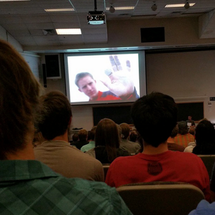 |
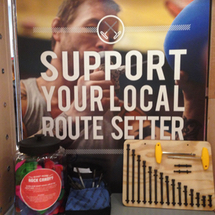 |

Climbing Business Journal is an independent news outlet dedicated to covering the indoor climbing industry. Here you will find the latest coverage of climbing industry news, gym developments, industry best practices, risk management, climbing competitions, youth coaching and routesetting. Have an article idea? CBJ loves to hear from readers like you!




